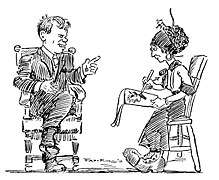Fay King (cartoonist)
Fay Barbara King (March 1889 – presumed dead [after 1954])[1] was an American illustrator, journalist, and cartoonist. Some of her work represents an early example of autobiographical comics.
Fay King | |
|---|---|
.jpg) Fay King circa 1913 | |
| Born | March 1889 Seattle, Washington, U.S. |
| Died | presumed dead[post 1954] |
| Nationality | American |
| Known for | illustration, cartoons, reportage |
| Spouse(s) | "Battling" Nelson (1913–1916) |



King worked for newspapers and magazines in the early twentieth century (at least from 1912 to 1937), moving to New York City in 1918. She was one of the popular Jazz Age cartoonists appearing in the 1924 comedy The Great White Way.
Biography
Fay Barbara King was born in Seattle, Washington in March 1889, to John and Ella King. She was raised in Portland, Oregon, and went to college at Seattle University. The young Fay King was adventurous, being one of the first women in the Portland Area to own an automobile,[2] and in 1912 had announced plans for a balloon ascension with noted early parachutist Tiny Broadwick, before the plan was rejected by her parents, according to an article in The Oregonian.[3]
King's father had been an employee at a Turkish bath, as well a trainer of athletes, and she seems to have had a deep affinity for sport.[2] King Married boxer "Battling" Nelson in 1913 in the Hegewisch neighborhood of Chicago.[4] Their divorce in 1916 was widely covered by the press.[5][6][7]
King worked for The Denver Post from April 1912 to 1918, leaving for The San Francisco Examiner. She later became feature writer and cartoonist for the New York Evening Journal.
In 1924, she appeared as herself in the comedy The Great White Way (alongside other cartoonists such as Winsor McCay and George McManus).
Work
King's cartoons are recalled as an early example of autobiographical comics within the genre of newspaper cartooning. She frequently depicted herself in her comics, using a spindly, gangly caricature that bore a strong resemblance to the character of Olive Oyl, who would later be created by E.C. Segar for his Thimble Theater strip.[8]
In addition to her autobiographical reporting, she is known to have created two strips, both of which ran in the New-York Mirror: "Mazie" (which ran briefly in 1924) and "Girls Will Be Girls" (which ran between 1924 and 1925).[9]
References
- Battling Nelson, The Durable Dane:World Lightweight Champion 1882–1954 by Mark Allen Baker c.2017 ISBN 978-1-4766-6372-2 (print)
- Holtz, Allan (January 22, 2013). "Ink-Slinger Profiles: Fay King".
- "Fay King Not To Soar". The Oregonian. August 12, 1911.
- "Battling Nelson Married". The New York Times. January 24, 1913.
- "Wife Platonic, "Bat" Testifies; Wins a Divorce". Chicago Daily Tribune. March 2, 1916.
- "Battling Nelson Granted Divorce From Fay King". Boston Daily Globe. March 8, 1916.
- "Would Sue Nelson: Father of Battler's Wife Says She Will Institute Divorce Proceedings". The Washington Post. March 1, 1913.
- "Fay King". Lambiek Comiclopedia. Lambiek.net. Retrieved March 11, 2017.
- Allan, Holtz (2012). American Newspaper Comics: An Encyclopedic Reference Guide. The University of Michigan Press. ISBN 9780472117567. OCLC 819171150.
Further reading
- Trina Robbins, Nell Brinkley and the New Woman in the Early 20th Century (2001), McFarland
- Trina Robbins, A Century of Women Cartoonists (1993), Kitchen Sink
External links
| Wikimedia Commons has media related to Fay King. |
Scrapbook, compiled by cartoonist and journalist, Fay King, 1916–1919 (from Digital Library@Villanova University)
- Articles about Fay King
- 2008 profile, by Marilyn Slater, Looking for Mabel
- 2013 profile, by Allan Holtz, Stripper's Guide
- 2017 profile, by Dick Kreck, The Denver Post
- Databases about Fay King
- Fay King at Lambiek Comiclopedia (minibio)
- Fay King at the Comic Book DB (archived from the original) (for A Century of Women Cartoonists)
- Fay King on IMDb (for The Great White Way)
- Articles by Fay King
- "Fay King Says Chop Sticks Should Have Hooks on Ends" (text and scan), Syracuse Evening Telegram, December 16, 1922